Discussion on log - Based operators for real-time text detection
The problem of text processing in natural
images is a core topic in the fields of image
processing (IP) and pattern recognition (PR).
Recent state-of-the-art methods and international
contests can be found in [1] and [2], respectively. A
key problem is to make the methods being timeefficient in order to embed into devices to support
real-time processing [3] [4] [5].
The real-time systems in the [1] [3], [4] [6], [7],
[8], [9], [10] apply the strategy of two stages
composing of detection and recognition. The
detection localizes the text components at a low
complexity level and groups them into text
candidate regions before classification. The
objective is to get a perfect recall for the detection
with a maximum precision for optimization of the
recognition. The two-stage strategy differs from the
end-to-end strategy, that applies template/feature
matching with classification using high-level
models for text entities [11]. The text elements in
natural images present specific shapes with
elongation, orientation and stroke width variation,
etc. as illustrated in Figure 1. This makes difficult
the detection problem. Therefore, various
approaches have been investigated in the literature
to design real-time and robust methods.
The recent works on the topic drive the text
processing as a blob detection problem with the
maximally stable extremal regions (MSER) [3], [5]
and the LoG-based operators [6], [8], [10], [4],
[12]. MSER looks for the local intensity extrema
and applies a watershed-like segmentation
algorithm for detection. The algorithm is processed
in a linear time complexity. It copes well with
background/foreground regions but is sensitive to
blurring. The Laplacian of Gaussian (LoG) operator
is a blob detector, but can be tuned to a stroke
detector with scale and orientation for better
characterization of text elements [10], [4].
Recently, LoG estimators have been proposed at a
linear-time complexity [13], [14] making the
operator competitive with MSER.
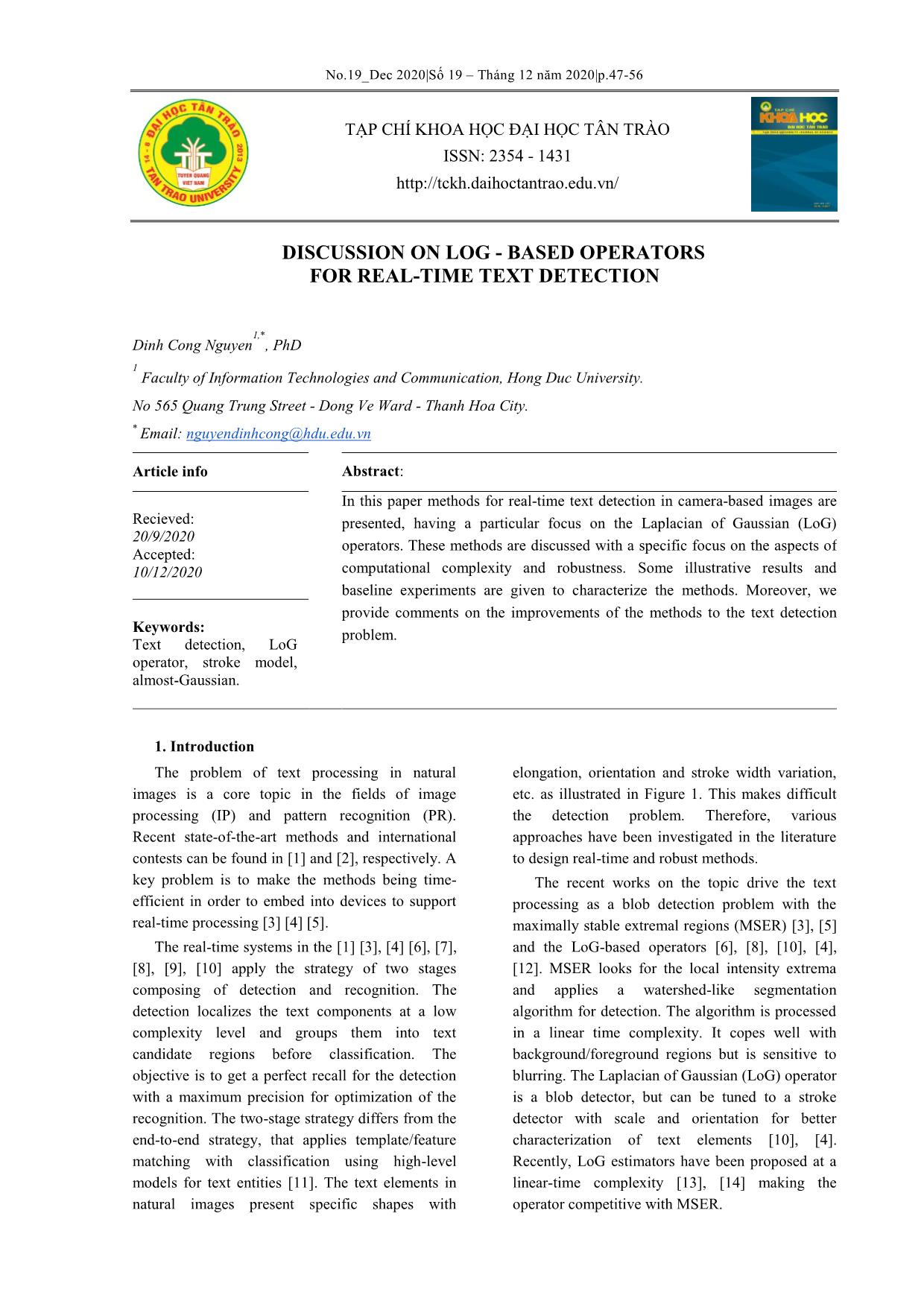
Trang 1
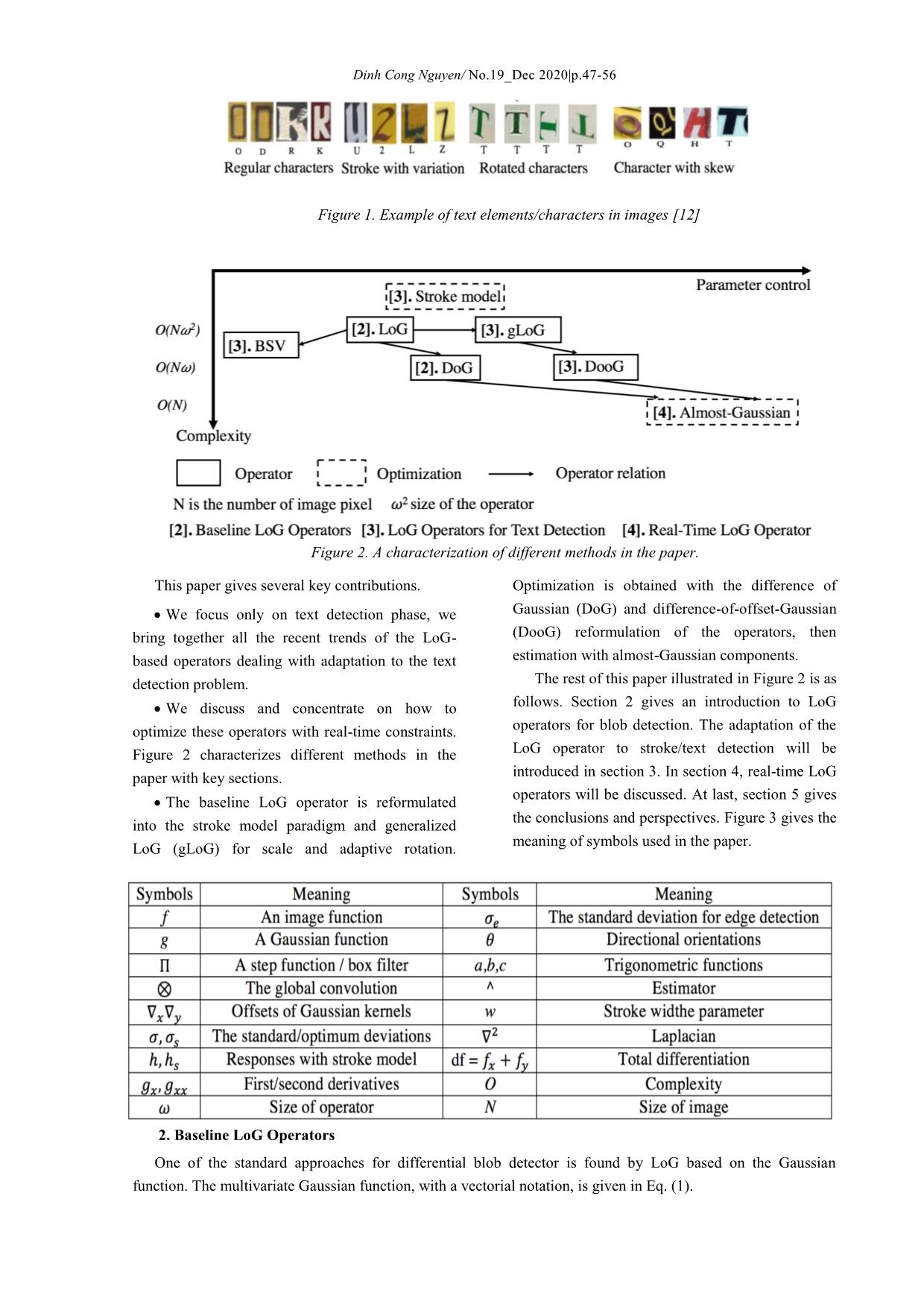
Trang 2
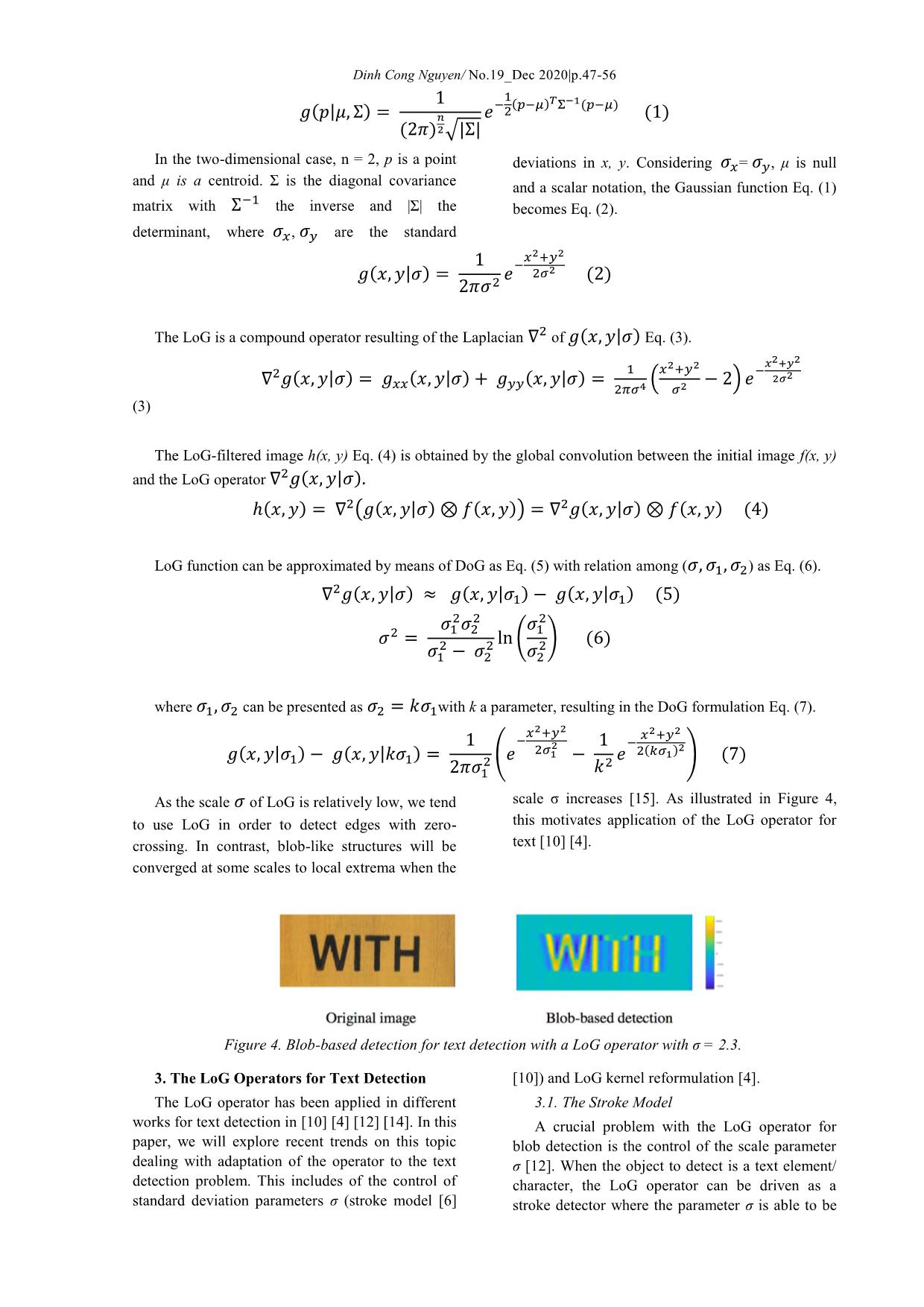
Trang 3
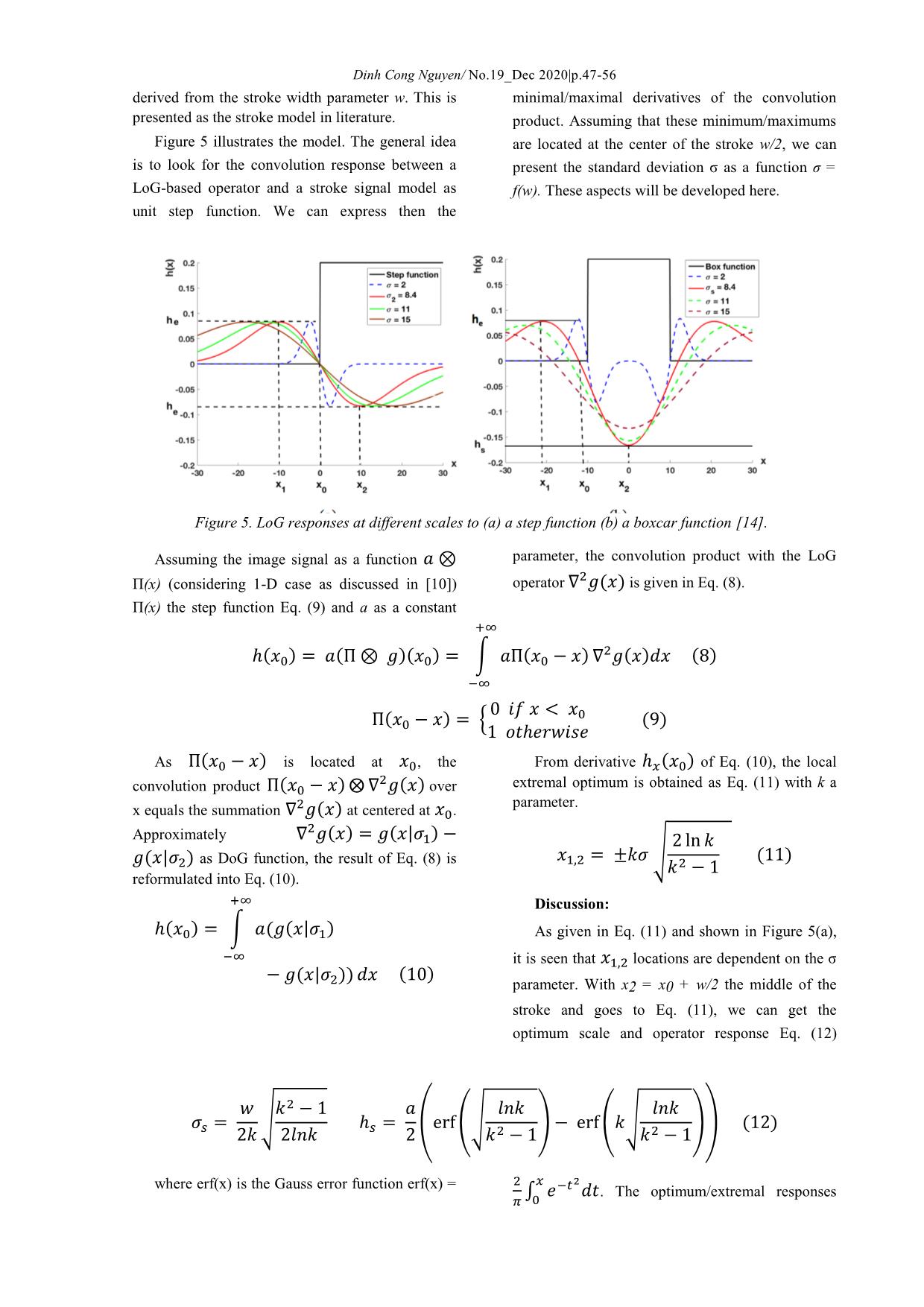
Trang 4
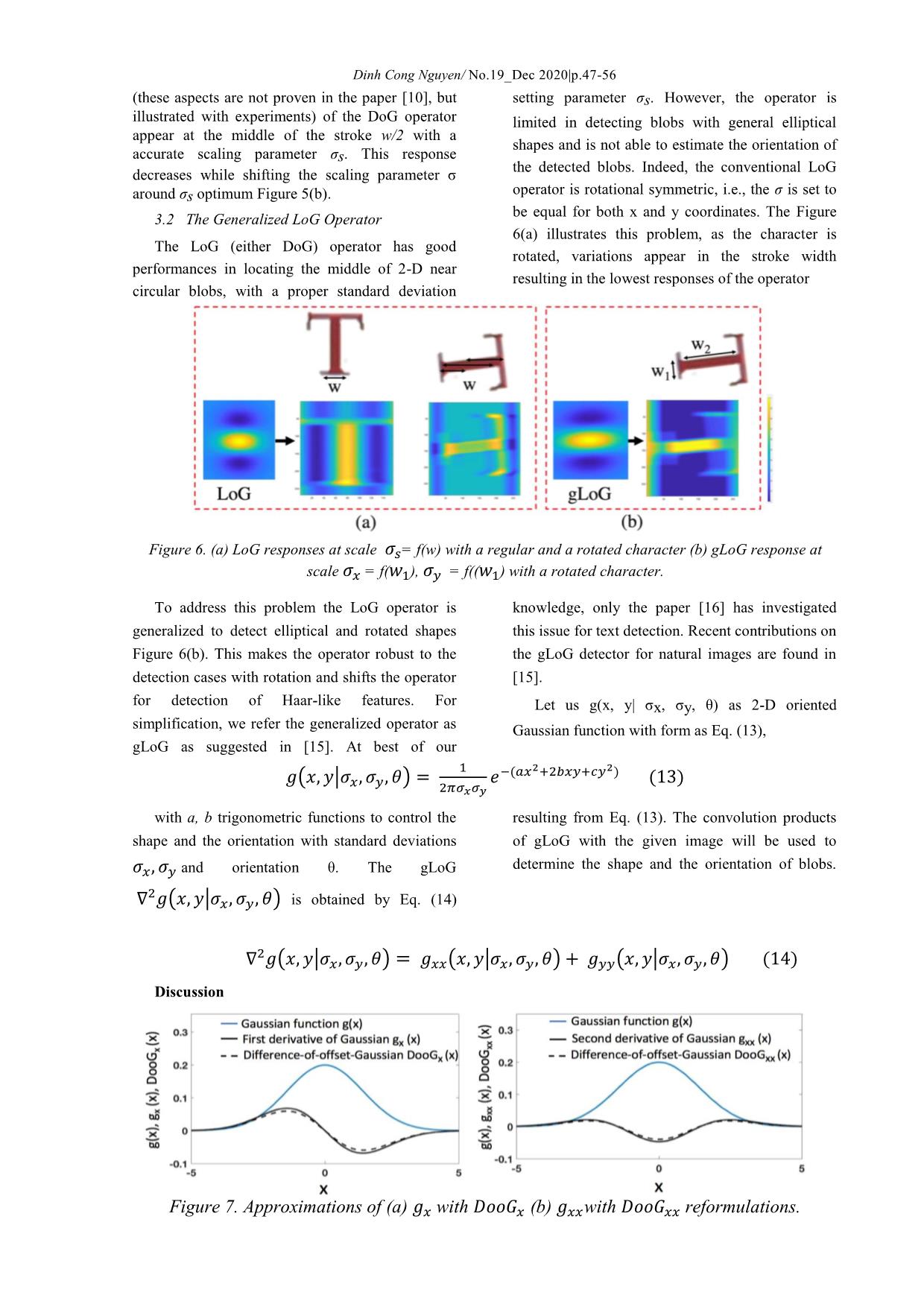
Trang 5
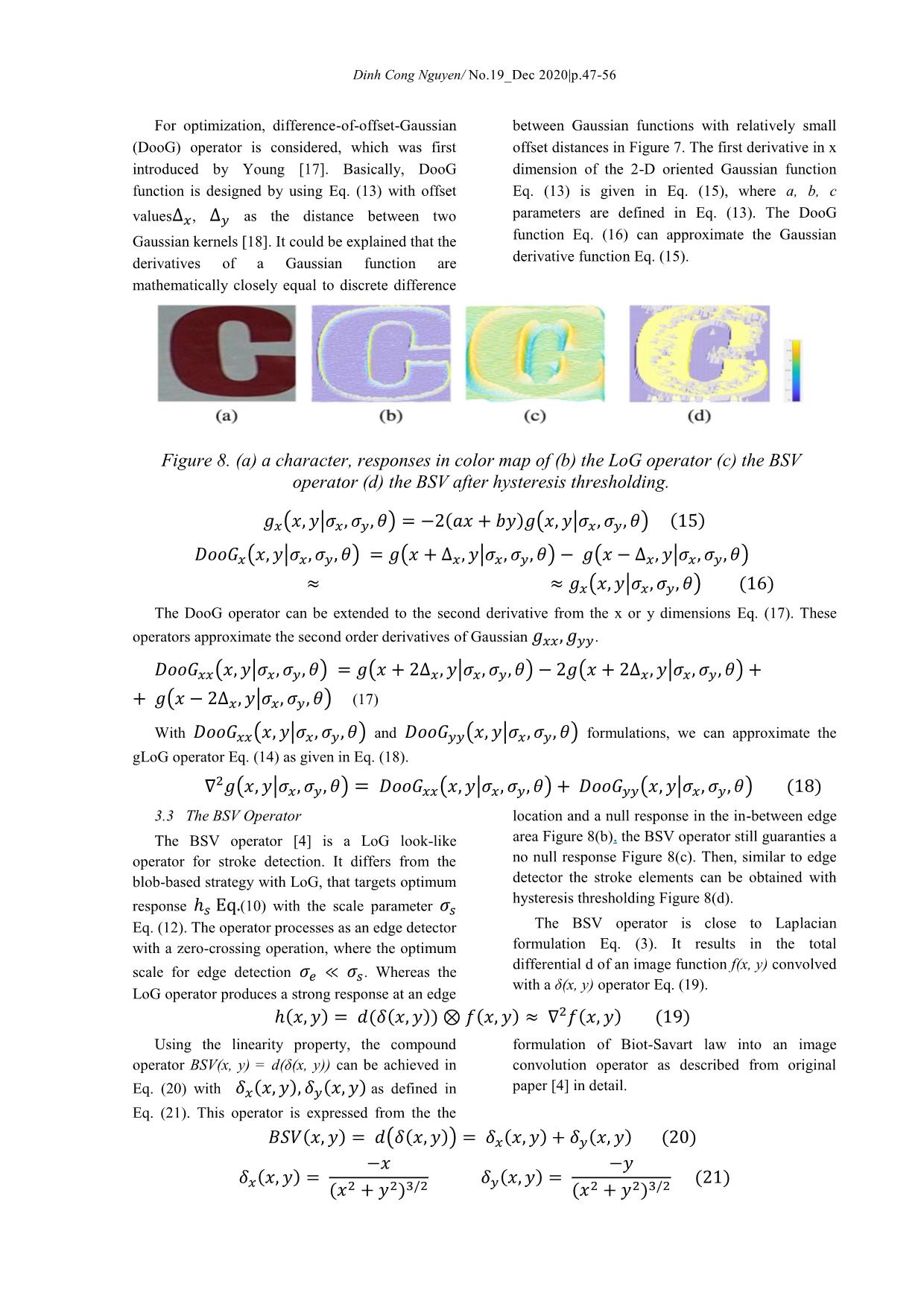
Trang 6
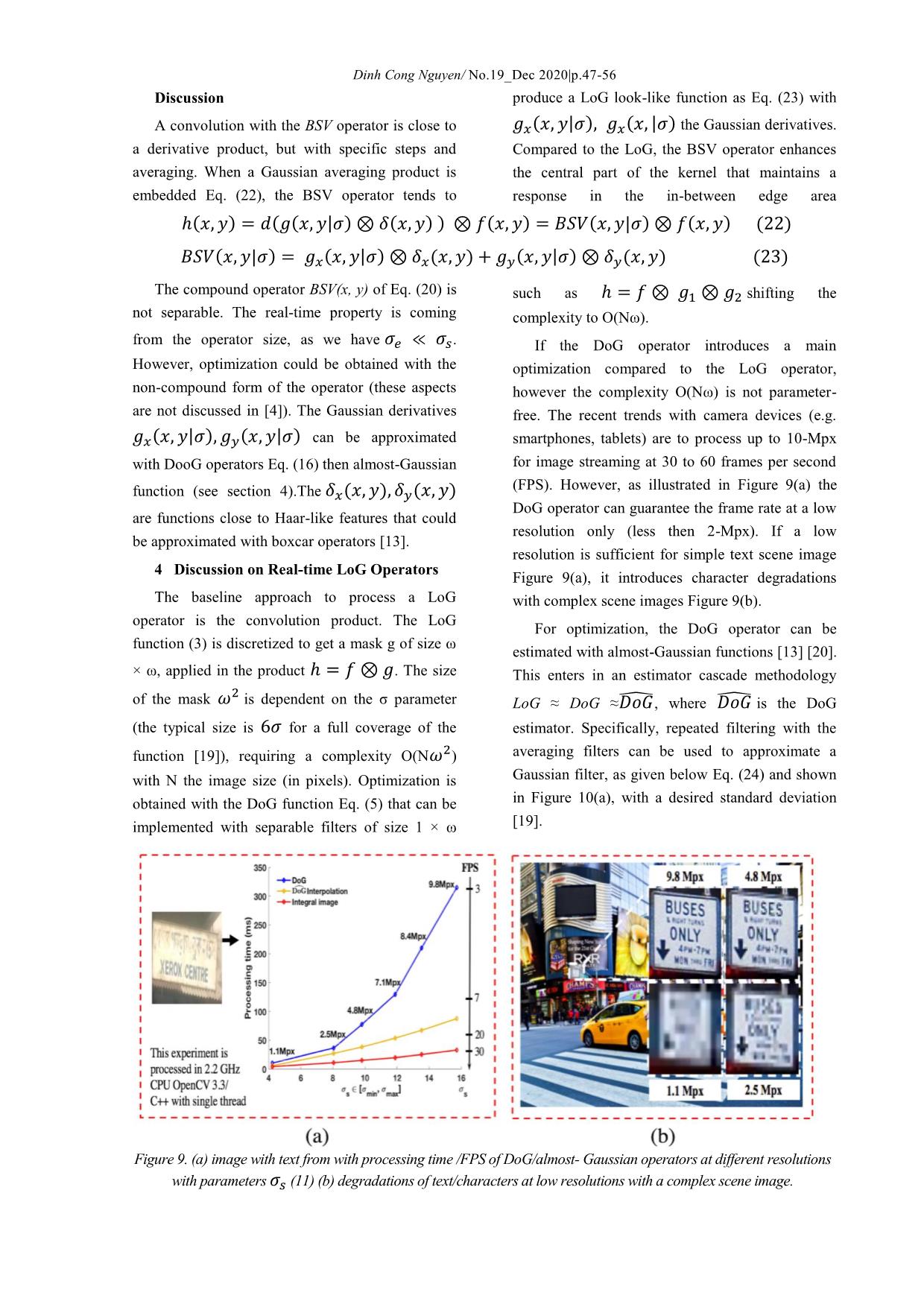
Trang 7
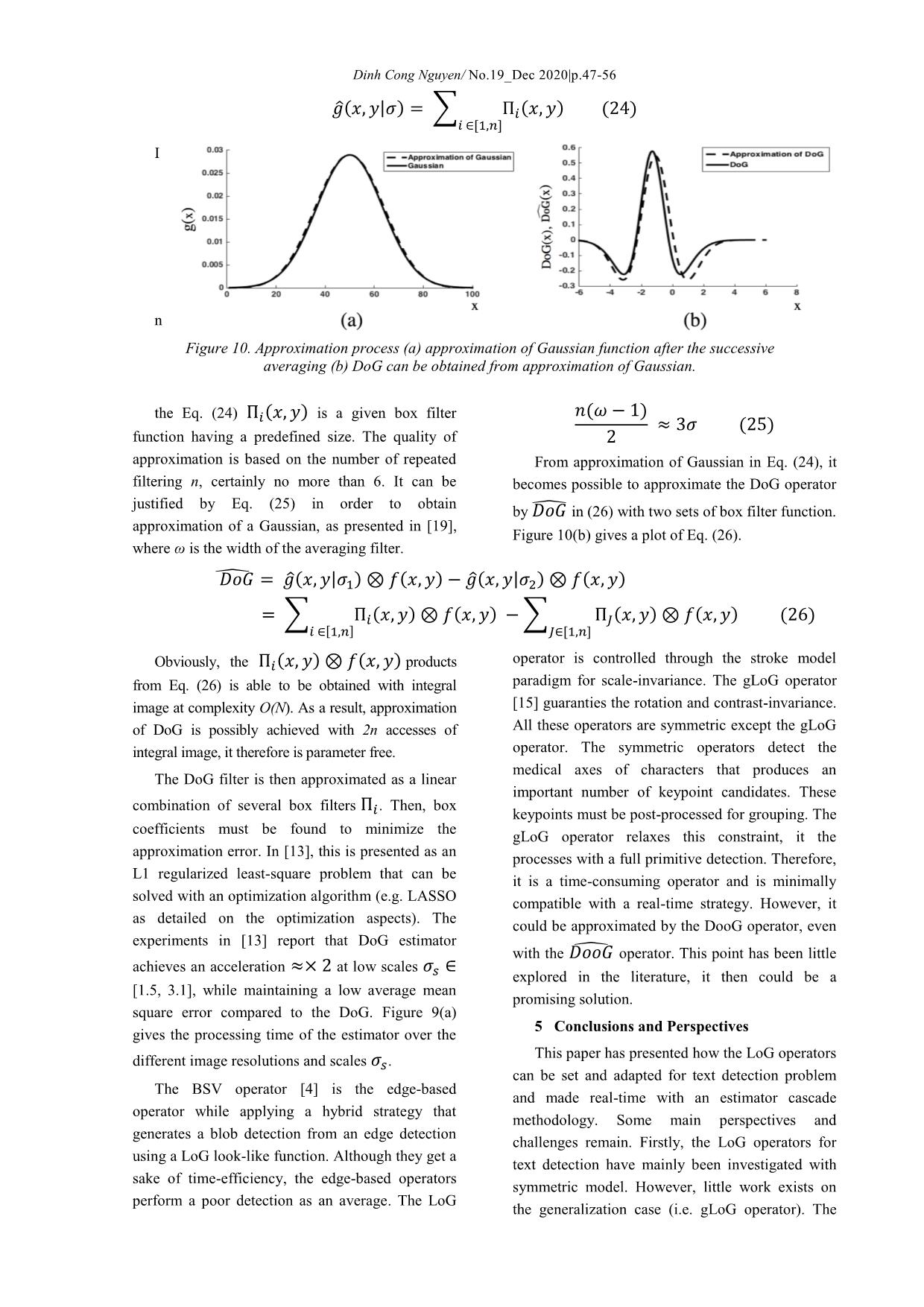
Trang 8
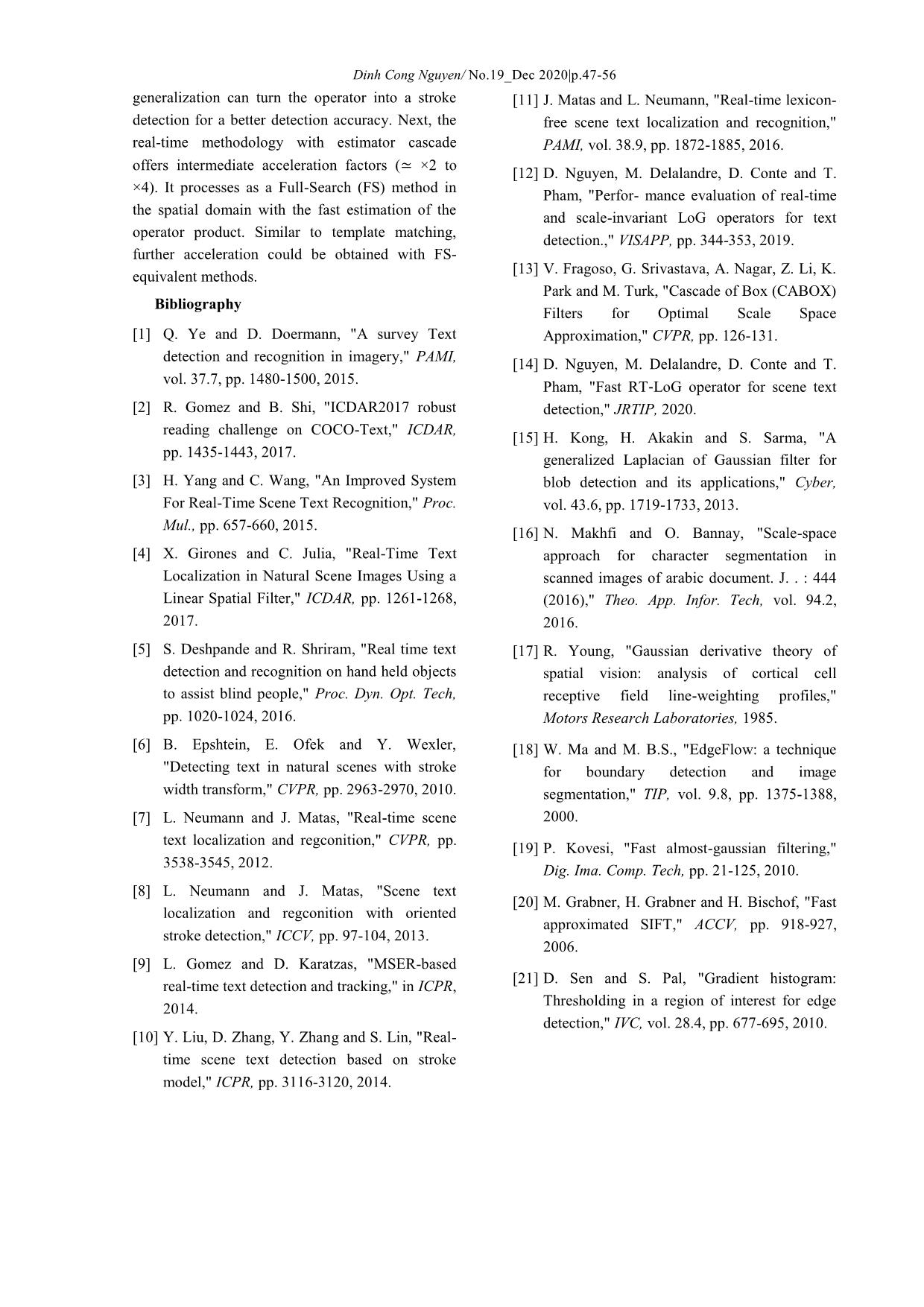
Trang 9
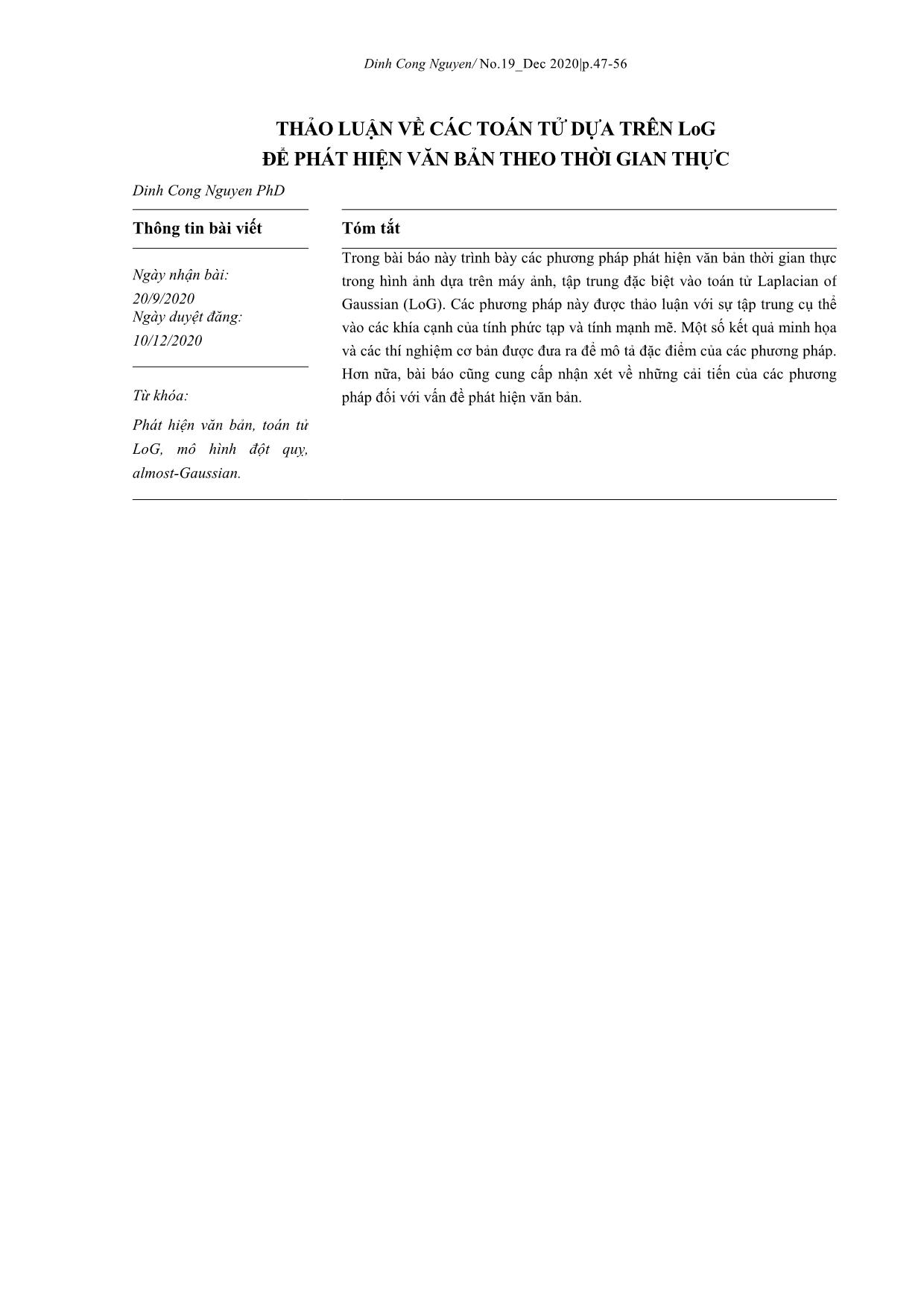
Trang 10
Tóm tắt nội dung tài liệu: Discussion on log - Based operators for real-time text detection
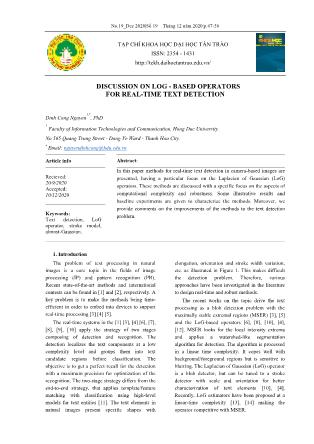
.47-56 (these aspects are not proven in the paper [10], but setting parameter σs. However, the operator is illustrated with experiments) of the DoG operator limited in detecting blobs with general elliptical appear at the middle of the stroke w/2 with a shapes and is not able to estimate the orientation of accurate scaling parameter σs. This response the detected blobs. Indeed, the conventional LoG decreases while shifting the scaling parameter σ around σs optimum Figure 5(b). operator is rotational symmetric, i.e., the σ is set to be equal for both x and y coordinates. The Figure 3.2 The Generalized LoG Operator 6(a) illustrates this problem, as the character is The LoG (either DoG) operator has good rotated, variations appear in the stroke width performances in locating the middle of 2-D near resulting in the lowest responses of the operator circular blobs, with a proper standard deviation Figure 6. (a) LoG responses at scale 휎푠= f(w) with a regular and a rotated character (b) gLoG response at scale 휎 = f(푤 ), 휎 = f((푤 ) with a rotated character. To address this problem the LoG operator is knowledge, only the paper [16] has investigated generalized to detect elliptical and rotated shapes this issue for text detection. Recent contributions on Figure 6(b). This makes the operator robust to the the gLoG detector for natural images are found in detection cases with rotation and shifts the operator [15]. for detection of Haar-like features. For Let us g(x, y| σx, σy, θ) as 2-D oriented simplification, we refer the generalized operator as Gaussian function with form as Eq. (13), gLoG as suggested in [15]. At best of our ( ) ( | ) ( ) with a, b trigonometric functions to control the resulting from Eq. (13). The convolution products shape and the orientation with standard deviations of gLoG with the given image will be used to determine the shape and the orientation of blobs. and orientation θ. The gLoG ( | ) is obtained by Eq. (14) ( | ) ( | ) ( | ) ( ) Discussion Figure 7. Approximations of (a) with 표표 (b) with 표표 reformulations. Dinh Cong Nguyen/ No.19_Dec 2020|p.47-56 For optimization, difference-of-offset-Gaussian between Gaussian functions with relatively small (DooG) operator is considered, which was first offset distances in Figure 7. The first derivative in x introduced by Young [17]. Basically, DooG dimension of the 2-D oriented Gaussian function function is designed by using Eq. (13) with offset Eq. (13) is given in Eq. (15), where a, b, c parameters are defined in Eq. (13). The DooG values , as the distance between two Gaussian kernels [18]. It could be explained that the function Eq. (16) can approximate the Gaussian derivatives of a Gaussian function are derivative function Eq. (15). mathematically closely equal to discrete difference Figure 8. (a) a character, responses in color map of (b) the LoG operator (c) the BSV operator (d) the BSV after hysteresis thresholding. ( | ) ( ) ( | ) ( ) ( | ) ( | ) ( | ) ( | ) ( ) The DooG operator can be extended to the second derivative from the x or y dimensions Eq. (17). These operators approximate the second order derivatives of Gaussian . ( | ) ( | ) ( | ) ( | ) (17) With ( | ) and ( | ) formulations, we can approximate the gLoG operator Eq. (14) as given in Eq. (18). ( | ) ( | ) ( | ) ( ) 3.3 The BSV Operator location and a null response in the in-between edge The BSV operator [4] is a LoG look-like area Figure 8(b), the BSV operator still guaranties a operator for stroke detection. It differs from the no null response Figure 8(c). Then, similar to edge blob-based strategy with LoG, that targets optimum detector the stroke elements can be obtained with hysteresis thresholding Figure 8(d). response (10) with the scale parameter Eq. (12). The operator processes as an edge detector The BSV operator is close to Laplacian with a zero-crossing operation, where the optimum formulation Eq. (3). It results in the total differential d of an image function f(x, y) convolved scale for edge detection ≪ . Whereas the with a δ(x, y) operator Eq. (19). LoG operator produces a strong response at an edge ( ) ( ( )) ( ) ( ) ( ) Using the linearity property, the compound formulation of Biot-Savart law into an image operator BSV(x, y) = d(δ(x, y)) can be achieved in convolution operator as described from original Eq. (20) with ( ) ( ) as defined in paper [4] in detail. Eq. (21). This operator is expressed from the the ( ) ( ( )) ( ) ( ) ( ) ( ) ( ) ( ) ( ) ( ) Dinh Cong Nguyen/ No.19_Dec 2020|p.47-56 Discussion produce a LoG look-like function as Eq. (23) with A convolution with the BSV operator is close to ( | ) ( | ) the Gaussian derivatives. a derivative product, but with specific steps and Compared to the LoG, the BSV operator enhances averaging. When a Gaussian averaging product is the central part of the kernel that maintains a embedded Eq. (22), the BSV operator tends to response in the in-between edge area ( ) ( ( | ) ( ) ) ( ) ( | ) ( ) ( ) ( | ) ( | ) ( ) ( | ) ( ) ( ) The compound operator BSV(x, y) of Eq. (20) is such as shifting the not separable. The real-time property is coming complexity to O(Nω). from the operator size, as we have ≪ . If the DoG operator introduces a main However, optimization could be obtained with the optimization compared to the LoG operator, non-compound form of the operator (these aspects however the complexity O(Nω) is not parameter- are not discussed in [4]). The Gaussian derivatives free. The recent trends with camera devices (e.g. ( | ) ( | ) can be approximated smartphones, tablets) are to process up to 10-Mpx with DooG operators Eq. (16) then almost-Gaussian for image streaming at 30 to 60 frames per second (FPS). However, as illustrated in Figure 9(a) the function (see section 4).The ( ) ( ) DoG operator can guarantee the frame rate at a low are functions close to Haar-like features that could resolution only (less then 2-Mpx). If a low be approximated with boxcar operators [13]. resolution is sufficient for simple text scene image 4 Discussion on Real-time LoG Operators Figure 9(a), it introduces character degradations The baseline approach to process a LoG with complex scene images Figure 9(b). operator is the convolution product. The LoG For optimization, the DoG operator can be function (3) is discretized to get a mask g of size ω estimated with almost-Gaussian functions [13] [20]. × ω, applied in the product . The size This enters in an estimator cascade methodology of the mask is dependent on the σ parameter LoG ≈ DoG ≈ ̂ , where ̂ is the DoG (the typical size is for a full coverage of the estimator. Specifically, repeated filtering with the function [19]), requiring a complexity O(N ) averaging filters can be used to approximate a with N the image size (in pixels). Optimization is Gaussian filter, as given below Eq. (24) and shown obtained with the DoG function Eq. (5) that can be in Figure 10(a), with a desired standard deviation implemented with separable filters of size 1 × ω [19]. Figure 9. (a) image with text from with processing time /FPS of DoG/almost- Gaussian operators at different resolutions with parameters 휎푠 (11) (b) degradations of text/characters at low resolutions with a complex scene image. Dinh Cong Nguyen/ No.19_Dec 2020|p.47-56 ̂( | ) ∑ ( ) ( ) I n Figure 10. Approximation process (a) approximation of Gaussian function after the successive averaging (b) DoG can be obtained from approximation of Gaussian. the Eq. (24) ( ) is a given box filter ( ) ( ) function having a predefined size. The quality of approximation is based on the number of repeated From approximation of Gaussian in Eq. (24), it filtering n, certainly no more than 6. It can be becomes possible to approximate the DoG operator justified by Eq. (25) in order to obtain by ̂ in (26) with two sets of box filter function. approximation of a Gaussian, as presented in [19], Figure 10(b) gives a plot of Eq. (26). where ω is the width of the averaging filter. ̂ ̂( | ) ( ) ̂( | ) ( ) ∑ ( ) ( ) ∑ ( ) ( ) ( ) operator is controlled through the stroke model Obviously, the ( ) ( ) products from Eq. (26) is able to be obtained with integral paradigm for scale-invariance. The gLoG operator image at complexity O(N). As a result, approximation [15] guaranties the rotation and contrast-invariance. of DoG is possibly achieved with 2n accesses of All these operators are symmetric except the gLoG integral image, it therefore is parameter free. operator. The symmetric operators detect the medical axes of characters that produces an The DoG filter is then approximated as a linear important number of keypoint candidates. These combination of several box filters . Then, box keypoints must be post-processed for grouping. The coefficients must be found to minimize the gLoG operator relaxes this constraint, it the approximation error. In [13], this is presented as an processes with a full primitive detection. Therefore, L1 regularized least-square problem that can be it is a time-consuming operator and is minimally solved with an optimization algorithm (e.g. LASSO compatible with a real-time strategy. However, it as detailed on the optimization aspects). The could be approximated by the DooG operator, even experiments in [13] report that DoG estimator with the ̂ operator. This point has been little achieves an acceleration at low scales explored in the literature, it then could be a [1.5, 3.1], while maintaining a low average mean promising solution. square error compared to the DoG. Figure 9(a) 5 Conclusions and Perspectives gives the processing time of the estimator over the This paper has presented how the LoG operators different image resolutions and scales . can be set and adapted for text detection problem The BSV operator [4] is the edge-based and made real-time with an estimator cascade operator while applying a hybrid strategy that methodology. Some main perspectives and generates a blob detection from an edge detection challenges remain. Firstly, the LoG operators for using a LoG look-like function. Although they get a text detection have mainly been investigated with sake of time-efficiency, the edge-based operators symmetric model. However, little work exists on perform a poor detection as an average. The LoG the generalization case (i.e. gLoG operator). The Dinh Cong Nguyen/ No.19_Dec 2020|p.47-56 generalization can turn the operator into a stroke [11] J. Matas and L. Neumann, "Real-time lexicon- detection for a better detection accuracy. Next, the free scene text localization and recognition," real-time methodology with estimator cascade PAMI, vol. 38.9, pp. 1872-1885, 2016. offers intermediate acceleration factors (≃ ×2 to [12] D. Nguyen, M. Delalandre, D. Conte and T. ×4). It processes as a Full-Search (FS) method in Pham, "Perfor- mance evaluation of real-time the spatial domain with the fast estimation of the and scale-invariant LoG operators for text operator product. Similar to template matching, detection.," VISAPP, pp. 344-353, 2019. further acceleration could be obtained with FS- [13] V. Fragoso, G. Srivastava, A. Nagar, Z. Li, K. equivalent methods. Park and M. Turk, "Cascade of Box (CABOX) Bibliography Filters for Optimal Scale Space [1] Q. Ye and D. Doermann, "A survey Text Approximation," CVPR, pp. 126-131. detection and recognition in imagery," PAMI, [14] D. Nguyen, M. Delalandre, D. Conte and T. vol. 37.7, pp. 1480-1500, 2015. Pham, "Fast RT‐LoG operator for scene text [2] R. Gomez and B. Shi, "ICDAR2017 robust detection," JRTIP, 2020. reading challenge on COCO-Text," ICDAR, [15] H. Kong, H. Akakin and S. Sarma, "A pp. 1435-1443, 2017. generalized Laplacian of Gaussian filter for [3] H. Yang and C. Wang, "An Improved System blob detection and its applications," Cyber, For Real-Time Scene Text Recognition," Proc. vol. 43.6, pp. 1719-1733, 2013. Mul., pp. 657-660, 2015. [16] N. Makhfi and O. Bannay, "Scale-space [4] X. Girones and C. Julia, "Real-Time Text approach for character segmentation in Localization in Natural Scene Images Using a scanned images of arabic document. J. . : 444 Linear Spatial Filter," ICDAR, pp. 1261-1268, (2016)," Theo. App. Infor. Tech, vol. 94.2, 2017. 2016. [5] S. Deshpande and R. Shriram, "Real time text [17] R. Young, "Gaussian derivative theory of detection and recognition on hand held objects spatial vision: analysis of cortical cell to assist blind people," Proc. Dyn. Opt. Tech, receptive field line-weighting profiles," pp. 1020-1024, 2016. Motors Research Laboratories, 1985. [6] B. Epshtein, E. Ofek and Y. Wexler, [18] W. Ma and M. B.S., "EdgeFlow: a technique "Detecting text in natural scenes with stroke for boundary detection and image width transform," CVPR, pp. 2963-2970, 2010. segmentation," TIP, vol. 9.8, pp. 1375-1388, [7] L. Neumann and J. Matas, "Real-time scene 2000. text localization and regconition," CVPR, pp. [19] P. Kovesi, "Fast almost-gaussian filtering," 3538-3545, 2012. Dig. Ima. Comp. Tech, pp. 21-125, 2010. [8] L. Neumann and J. Matas, "Scene text [20] M. Grabner, H. Grabner and H. Bischof, "Fast localization and regconition with oriented approximated SIFT," ACCV, pp. 918-927, stroke detection," ICCV, pp. 97-104, 2013. 2006. [9] L. Gomez and D. Karatzas, "MSER-based [21] D. Sen and S. Pal, "Gradient histogram: real-time text detection and tracking," in ICPR, Thresholding in a region of interest for edge 2014. detection," IVC, vol. 28.4, pp. 677-695, 2010. [10] Y. Liu, D. Zhang, Y. Zhang and S. Lin, "Real- time scene text detection based on stroke model," ICPR, pp. 3116-3120, 2014. Dinh Cong Nguyen/ No.19_Dec 2020|p.47-56 THẢO LUẬN VỀ CÁC TOÁN TỬ DỰA TRÊN LoG ĐỂ PHÁT HIỆN VĂN BẢN THEO THỜI GIAN THỰC Dinh Cong Nguyen PhD Thông tin bài viết Tóm tắt Trong bài báo này trình bày các phương pháp phát hiện văn bản thời gian thực Ngày nhận bài: trong hình ảnh dựa trên máy ảnh, tập trung đặc biệt vào toán tử Laplacian of 20/9/2020 Gaussian (LoG). Các phương pháp này được thảo luận với sự tập trung cụ thể Ngày duyệt đăng: vào các khía cạnh của tính phức tạp và tính mạnh mẽ. Một số kết quả minh họa 10/12/2020 và các thí nghiệm cơ bản được đưa ra để mô tả đặc điểm của các phương pháp. Hơn nữa, bài báo cũng cung cấp nhận xét về những cải tiến của các phương Từ khóa: pháp đối với vấn đề phát hiện văn bản. Phát hiện văn bản, toán tử LoG, mô hình đột quỵ, almost-Gaussian.
File đính kèm:
 discussion_on_log_based_operators_for_real_time_text_detecti.pdf
discussion_on_log_based_operators_for_real_time_text_detecti.pdf

